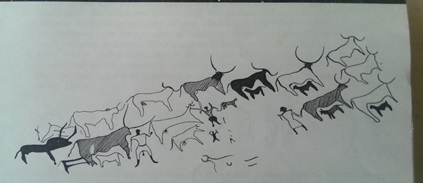By Said M-Shidad Hussein
Abstract:
The purpose of this study is to shed more light on the location of ancient land of Punt and the nature of its relationship with ancient Egypt through discussion on the following points: origin of Somali history (introduction); review of the opposite arguments on the location of Punt; Punt as a kingdom; the scope of its trade; the evidences in the exported Plants and Animals; Greco-Roman account for the location of Punt; linguistic evidences; ethnographic significance of Puntite names; genetic evidence; archaeological and cultural connections; continuation of commercial aspect; Conclusion.
Note: In this document, as in many of other records, the names Somali, Somaliland, Somali Peninsula, and the Eastern Horn of Africa are substitutable; the terms ‘North East Africa’ and ‘Horn of Africa’ (from Sudan to the north and the east of Kenya) also do mean the same thing, although if it’s said ‘the Horn’ only, it usually refers to the Somali Peninsula, not the greater Horn of Africa; but still the term ‘Horn of Africa’ is used elastically depending on the context. On the same token, the terms Southwest Asia, Near East, and Middle East are interchangeable.
I.Introduction: Origins of Somali History
Origin:
Notwithstanding some previously-presented hypotheses on origin of the Somalis, Somalia is a six millennia-old nation that has been occupying the Somali Peninsula throughout the time of its history. Even the last and most accepted one of these hypotheses which originates the Somali from Omo-Tana region cannot be valid anymore, and it is not logical even, because of various, ignored accounts.

These accounts clearly suggest that the ancestral home of the Somalis was the northern part of the Peninsula with the Peninsula always being inhabited by the Somalis.[i] In one of the recent studies on Somali history in general and reassessments of Omo-Tana story in particular, an intimate authority has announced:
“this hypothesis cannot be taken uncritically because cave paintings, dating back to 9,000 BCE, found in northern Somalia, as well as studies of ancient pyramids, ruined cities, and stone walls confirm that an ancient civilization thrived here at least from the late Paleolithic or Stone Age… along with the fact that the ancient Kingdom of Punt once flourished within Somali borders’…
‘Somalia is a nation with a history that stretches back more than ten millennia to the beginnings of human civilization’.”[ii]
I have come to a similar conclusion on the question over six years ago. Somalia is one of not so many countries around the world in which a population change has never been indicated, and any sign of a noticeable substratum has not so far been observed genetically, linguistically, and anthropologically. There is no evidence for south-emanated expansion toward the north, but there are evidences for the opposite. The largest lexical statistics, and other linguistic standards, from various Afroasiatic languages are used in a forthcoming comparison for reconstructing the Somali history.[iii]
Affiliation:
This does not necessarily mean that the Somalis were the first humans who have populated the Horn. In fact, Old and Middle Stone Ages (Paleolithic & Mesolithic) cultures were observed across the Somali Peninsula and relating areas. We can particularly mention the Mesolithic, and Neolithic (New Stone Age) artifact cultures from 10,500 BP (before present) in the Peninsula, which are named after their respective primary site: Magosian 10,500-7,500 Bp found in Dirir Dhabe, Goday, and Buur Haybe; Hargeysan 9,500-7,500 Bp in Nugaal-Sanaag-Dirir Dhabe belt; Doyan 7,000-4,000 Bp across Nugaal-Jubba region; Wiltoniod 7,500-5,000 Bp in Hargeysa-Nagele (Upper Daawa) belt. The times and locations are in approximation here.
Magosian and Wiltoniod were also found in Afarland. Besides the well-known Capsian culture, which is particularly connected with North Africa, Magosian and Wiltoniod were also discovered from some sites in East Africa. These cultures, as such, overlap in times and artifacts.
Besides these Mesolithic and Neolithic cultures, a pastoralist culture also appeared throughout that period. The linguistic comparisons provide a significant information on a Cushitic civilization of fully food producing and settled life in the region about 7,000 BP or earlier, in connection with the developments in the Near East, Nile Valley (Egypt and Sudan), North Africa, and Sahara.[iv]
Apart from the Somali Peninsula, material evidences of this culture in the region dating from 5,500 BP approximately have been found in Afarland – NW of Harar (cattle); north east of Lake Turkana (cattle, goats/sheep, pottery – some dating to 7,000 BP); Upper Daawa – the southern tributary of Jubba River (cattle, camel, sheep, goats; and pottery); Axum area, in northern Ethiopia (camel and pottery); and Putana Plain in eastern Sudan (cattle).[v]
We welcome the submission of all articles for possible publication on WardheerNews.com. WardheerNews will only consider articles sent exclusively. Please email your article today . Opinions expressed in this article are those of the author and do not necessarily reflect the views of WardheerNews.
WardheerNew’s tolerance platform is engaging with diversity of opinion, political ideology and self-expression. Tolerance is a necessary ingredient for creativity and civility.Tolerance fuels tenacity and audacity.
WardheerNews waxay tixgelin gaara siinaysaa maqaaladaha sida gaarka ah loogu soo diro ee aan lagu daabicin goobo kale. Maqaalkani wuxuu ka turjumayaa aragtida Qoraaga loomana fasiran karo tan WardheerNews.
Copyright © 2024 WardheerNews, All rights reserved


